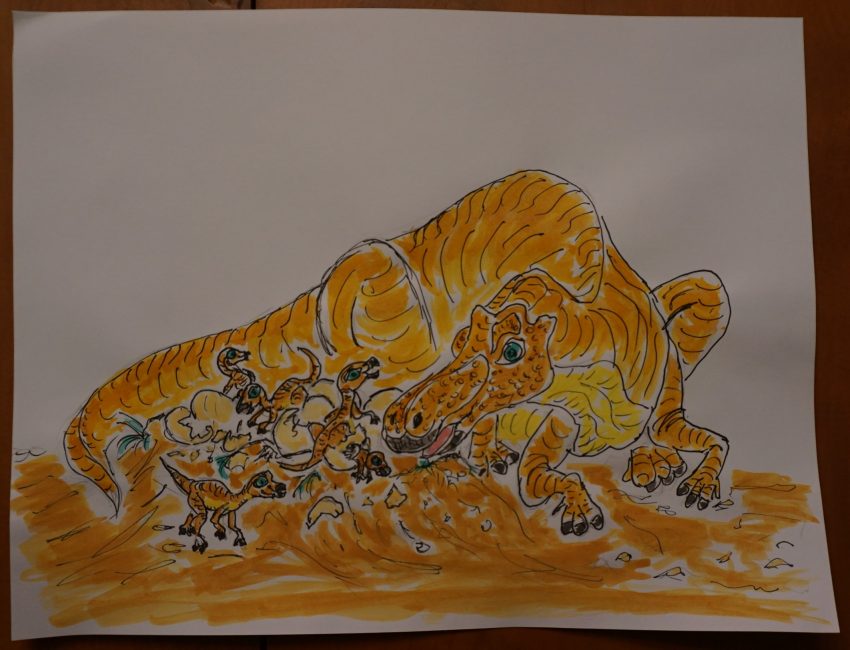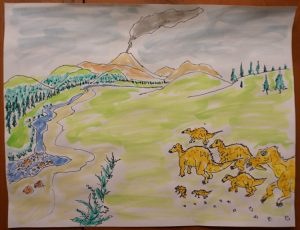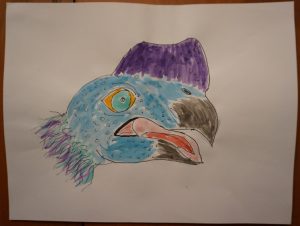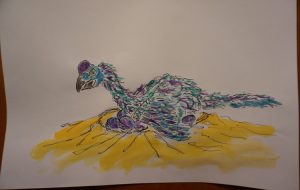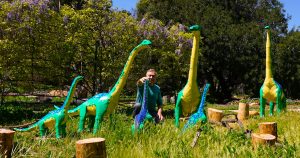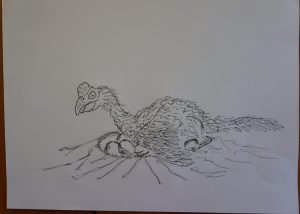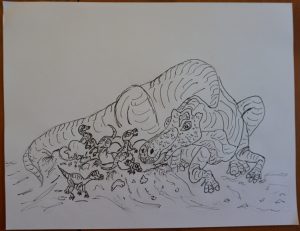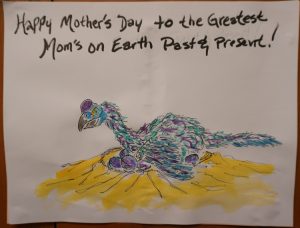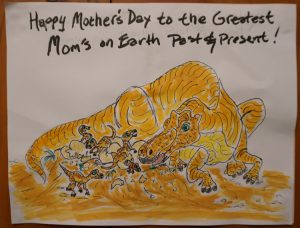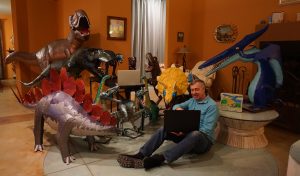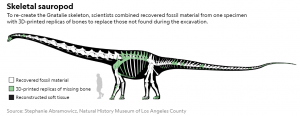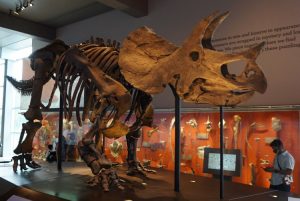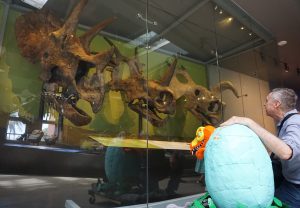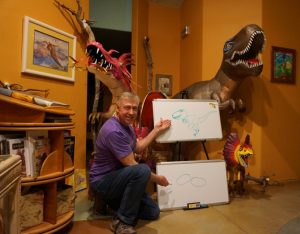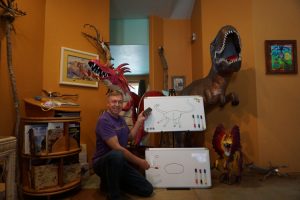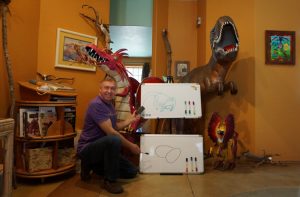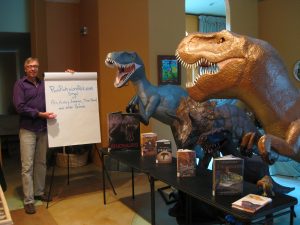Mother’s Day is Sunday and Father’s Day is next Month. Now is a Great Time to discuss Nurturing Habits of Dinosaurs. Did Dinosaurs take care for their Young? Or did they lay their eggs and leave? Maiasaura means “Good Mother Lizard”. Maiasaura a Hadrosaur was the first species to prove conclusively that some Dinosaurs were keen parents that actively watched and fed their young. Jack Horner & Bob Makela discovered a 75 Million Year Old Nesting Ground preserved in the Cretaceous Rocks of Montana contained numerous Nests of 30 to 40 Eggs the size of a rugby ball. Bones of small embryos, juveniles and adults were found alongside the nests suggesting that Maiasaura nested in large groups. The bones of the hatchlings were very weak (the size of rabbits), their movement would have been slow and awkward requiring assistance with feeding. And yet, their teeth reflected signs of wear from eating plants. Therefore, the parents must have gathered food for their young and weaned them during early life. Hatchlings weighed about 2.2 lbs. and measured less than 2 feet. Adults however, weighed 3 tons and were 30 feet in length. Like modern Birds, Maiasaura grew exceptionally fast reaching Adult Size in less than 10 years.
Maiasaura had a long skull with a downturned beak and jaws packed with a battery of teeth. Maiasaura not only nested in colonies but traveled in herds. One site contains the remains of at least 10,000 individuals ranging from juveniles to adults. The largest bonebed ever found. It’s believed that Maiasaura traveling in large herds aided in protecting them from Tyrannosaurides and other Large Predators.
Oviraptor was discovered in the early 1920’s by Roy Chapman Andrews during his Central Asiatic Expedition to Mongolia. It was found on top of a nest that they assumed belong to Protoceratops. As a result, it was given the name Oviraptor – “Egg Thief” believing this theropod ate the eggs of other dinosaurs. In the 1990’s expeditions to Mongolia recovered evidence that the small bones in the supposed Protoceratops eggs were actually the embryos of Oviraptor! Another fossil showed Oviraptor sitting on a nest in a protective fashion covering and warming the eggs like a mother bird. Oviraptor was not a thief, but a caring parent. Unfortunately, once a dinosaur is named there is not a process for changing it. Therefore, this good parent has a bad name. Oviraptor is a cousin of Tyrannosaurus and Allosaurus, but you wouldn’t think so by its appearance. Oviraptor measured about 7 feet long and weighed 88 lbs. Its skull was completely toothless but had a strong beak. This beak could crack nuts or perhaps aided with eating shellfish. It had a prominent crest too weak to act as a defensive weapon, but most likely for display.
Sauropods are believed to have laid their eggs and wandered off. Based on the massive size of the Sauropods it probably would have been best. Their eggs were laid in numbers of 30 -50 at a time the size of a softball or large grapefruit. Nest of many sauropods have been discovered at the same site with their proximity to each other leaving little room for one adult sauropod to roam between them. Therefore, any misstep would have been disastrous! This adds to the theory that the eggs were laid and left. Studies of Rapetosaurus krausei a sauropod that lived in Madagascar 70 – 66 Million Years Ago indicate that the bones of hatchlings were developed allowing them to seek food on their own. At hatching the size of a Chihuahua (5 lbs.) reaching in as little as 3 months 50 lbs. or the size of a Golden Retriever. Rapetosaurus research demonstrated these sauropods ability to grow and survive without the attention of parents at hatching.
FYI: the largest egg was laid by a bird Aepyornis “the Elephant Bird”! Perhaps the largest bird to have ever lived. Although flightless Aepyornis was just under 10 feet tall and around 520 lbs. This bird went extinct about 30,000 years ago on the island of Madagascar when humans arrived. Their eggs were 12 inches long – 180 times larger than a chicken egg and 7 times larger than an ostrich egg! Evidence has been found that humans used their eggs for bowls. In addition, egg shells have been excavated around fire pits suggesting the eggs were used to feed entire families!
Make a card for your Mother. Cardstock, flower shapes and some drawings can make something special for Your Mother’s Day. Sketch with 2B pencil, ink with 0.5 pen, add watercolors then attach to card stock using glue.
So, what would you give your Dinosaur Mom for Mother’s Day? Well maybe fruits, nuts or a nice leafy branch for a Herbivore. Add a few insects and perhaps a small reptile or mammal could please your Omnivore Mom. I think we can all guess what would make your favorite carnivore happy. Like today a few extra chores around the Dinosaur Den could put a smile Dinosaur Mom.
Thank You to All the Mom’s Across the Globe and Across Time for their Unconditional Love.
Happy Mother’s Day
Stay Tuned for More Dinosaur Fun Facts, Fiction & Crafts!
Consider a Membership with the Museum. In addition to Supporting Their Valuable Work there are Benefits to You. Special Preview Events for Members Only as well as Virtual Access Exclusive for Members. Below are 3 of my favorites Museums. For more information and access to general public eLearning check out the links below.
The Natural History Museum of Los Angeles County www.nhm.org under Research & Collections / Digitized Collections will allow you to browse their Collections. Check out the latest Activities on their site. Look for Gnatalie the Green Dinosaur! Plus T-Rex in 3D a Prehistoric Movie!
The American Natural History Museum www.amnh.org You will find eLearning for Families, Students & Educators. Explore the Museum Virtually. Check Out SciCafe: Video Talks and Meet the Icons: Stories behind the Exhibits! There are Video Series covering Behind the Scenes at the Museum with Space & Dinosaur Explainers.
Chicago’s Field Museum www.fieldmuseum.org You can talk to “Maximo the Titanosaur” online, Yes Really! Visit Sue the largest T-Rex discovered! Check Out “Brain Scoop” and the Learning Resources – many are also in Spanish.
Check Out Your Libraries eBooks. My local Library has over 900 eBooks on Dinosaurs! Here are four books for Drawing Dinosaurs that you might find at your Library. Ask your Librarian about others.
1-2-3 Draw Dinosaurs and other Prehistoric Animals A step by step guide by Freddie Levin (2001)
Draw 50 Dinosaurs and other Prehistoric Animals by Lee J. Ames (1977)
Draw it Dinosaurs by Patricia Walsh (2006)
I Can Draw Dinosaurs by Terry Longhurst (2003)
Stay Safe & Well
“Encouraging the Appreciation of Art and Education through the Inspiration of Dinosaurs”
Paul & Prehistoric Pals
Your feedback is appreciated, comment below or email:
Thank you!
